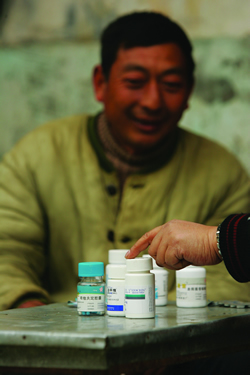Antiretroviral Treatment Outcomes in China
October 2009–An estimated 700,000 people are living with HIV in China. By August 2008, more than 52,000 had started antiretroviral treatment (ART) through the Chinese government's free program.

A treatment education session in Hubei Province, China. (Photo: Carl Grobl) |
A recent evaluation of the program's first five years reported on treatment outcomes for 48,785 ART-naïve, adult patients who were started on triple-drug combinations.1 More than half (53 percent) were infected through contaminated blood products and 82 percent were living in rural areas. Their baseline CD4 count before starting ART was a median of 118 cells/mm3. Almost all patients (91 percent) received nevirapine (NVP) in combination with zidovudine (AZT) or stavudine (d4T), and didanosine (ddI) or lamivudine (3TC). The study showed that deaths were highest in the first three months of ART, occurring in five percent of all patients. Mortality rapidly dropped by six months of ART, and at five years 76 percent of patients were alive. Patients were more likely to die if they had lower CD4 cell counts and more clinical symptoms of HIV disease before starting ART.
In a subset of 31,070 patients who had more detailed laboratory information, one-fourth failed treatment based on their CD4 cell counts over the five-year period. Half of all patients who had reached the five-year point failed treatment.
The results of China's national program show that scale-up of ART was achieved across a wide geographic region in largely rural areas and that early mortality was quickly reduced within six months. Starting patients on ART at higher CD4 cell counts and before advanced clinical disease could lead to even lower early mortality rates.
Although the risk of treatment failure was very high, the failures were identified through CD4 cell count alone and not viral load. As CD4 by itself has been shown to be a poor predictor of treatment failure, it is likely that these are overestimates. Unreliable diagnoses of treatment failure could lead to unnecessary treatment switches, leaving people with HIV with fewer antiretroviral options in the future and higher costs to programs for second-line drugs.
1 Zhang F, et al. Five-year outcomes of the China National Free Antiretroviral Treatment Program. Annals of Internal Medicine 2009, volume 151, pages 241-251.
TRANSLATIONS > Chinese [pdf]